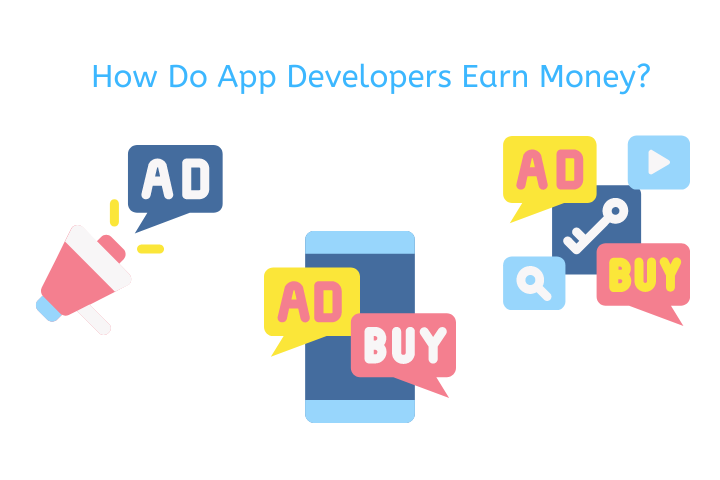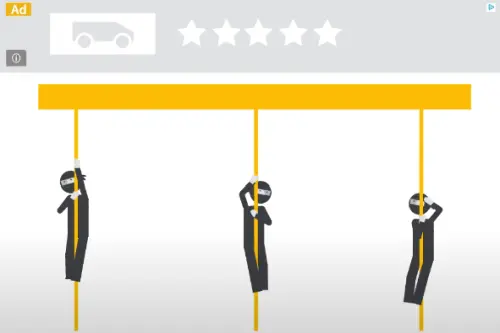How Do App Developers Earn Money?
With over 5 million apps in the App Store and Google Play combined, it’s no secret that app development is a hugely lucrative industry. But how do app developers actually make money? Read on to find out the various ways app developers can monetize their creations.

Advertising
Advertising is the main source of revenue for many free apps. In-app advertising allows app developers to show ads within their app, and earn money each time a user views or clicks on an ad. This type of monetization is often used in games and other entertainment-focused apps, as users are typically more engaged with these types of apps and are therefore more likely to.
Advertisements come in many different forms:
- Banner ads: They are typically small rectangular ads that appear at the top or bottom of the screen. They are relatively unobtrusive and can be an effective way to generate revenue from your app. However, banner ads can also be easily ignored by users, and click-through rates tend to be relatively low.

- Interstitial ads: They are the most intrusive and therefore the most likely to be annoying to users. , Interstitial ads are full-screen ads that are shown at natural breakpoints in-between content (such as when a user opens a new level in a game).
- Video ads: Video ads in a mobile app can take many different forms, but they all serve the same purpose: to promote and sell products or services. Typically, video ads are short clips that play automatically before or after another video or page switch. These ads can be anywhere from 10 to 30 seconds long, and they usually feature product demonstrations or testimonials. In some cases, video ads may also include discounts or other special offers. Regardless of their format, video ads are designed to grab attention and persuade viewers to make a purchase.
- Native ads: Native ads are a type of advertisement that blends in with the surrounding content. They are typically found in mobile apps and are designed to match the look and feel of the app itself. Native ads are placed within the app’s normal flow of content, making them less intrusive than other forms of advertising. Because they blend in with the app, native ads can be more effective at capturing users’ attention. However, they can also be more difficult to notice, which may result in users ignoring or overlooking them.
- Incentivized ads: Incentivized ads are a type of video ad that offers users a reward, such as an in-game currency or lives, for watching the ad all the way through. This type of ad is becoming increasingly popular as it provides a way for users to earn rewards without having to make a purchase. However, some critics argue that incentivized ads are simply another way for companies to pressure users into watching more ads. Others argue that these ads are no different than any other form of advertising and that users should be free to choose whether or not they want to watch them.
In-App Purchases
As the mobile app market continues to grow, so does the competition among app developers. In order to stand out and generate revenue, many developers are opting for in-app purchases instead of ads.
In-app purchases allow users to buy digital or physical goods within the app itself, which can be anything from unlocking new features or levels in a game to buying a virtual currency that can be used to make in-app purchases.
The advantage of in-app purchasing is that it provides a more seamless user experience and can be less intrusive than ads. Additionally, it offers developers a more direct way to generate revenue from their apps.
However, it is important to note that in-app purchases must be carefully designed and implemented in order to avoid frustrating or alienating users. When done right, in-app purchases can be a great way for developers to monetize their apps.
In order to charge for in-app purchases, developers must first set up an account with iTunes Connect or Google Play Developer Console. Once that’s done, they can start adding product names, descriptions, and prices. It’s important to note that all in-app purchases must be approved by Apple or Google before they can go live.
Subscriptions
Another way to monetize an app is through subscriptions. With subscriptions, users pay a recurring fee (usually on a monthly or yearly basis) in order to access premium content or features. This could include anything from access to exclusive videos or audio content to premium filters for photo editing apps.
Subscriptions offer a few advantages for both app developers and users. For developers, it provides a steadier stream of revenue, as users are paying regularly. This can be helpful in planning and budgeting for future development costs. Subscriptions can help to increase customer loyalty, as users are more likely to stick with a service that they’re already paying for.
From the user’s perspective, subscriptions can offer convenient access to premium content without having to make individual purchases. They also provide peace of mind, as users know that they won’t have any unexpected charges popping up. Furthermore, many subscription services offer discounts or free trials to first-time users, which can help to entice new customers.
In order to offer subscriptions, developers must have an active membership with iTunes Connect or Google Play Developer Console. Once that’s done, they can start setting up their subscription products by choosing from a variety of options, such as duration (e.g., one month, six months, one year), trial period (e.g., three days), and price (e.g., $0.99/month).
Affiliate Income
With affiliate income, developers earn a commission on sales generated from links within their app. For example, if a user clicks on an affiliate link and makes a purchase, the developer would receive a commission from the company whose product was purchased.
Affiliate income can be a great way for developers to generate revenue without having to directly sell products or services. Additionally, it can be less intrusive than ads, as users are only redirected to an external website if they choose to click on the affiliate link.
However, affiliate income can be unpredictable, as it is entirely dependent on whether or not users click on the links. Additionally, companies may change their commission rates or terminate their affiliate programs at any time, which could impact a developer’s income.
To start generating affiliate income, developers must first sign up with an affiliate program. Once they’re accepted into the program, they’ll be given a unique link that they can add to their app. When a user clicks on the link and makes a purchase, the developer will earn a commission.
Sponsorship
With sponsorship, developers partner with companies or brands in order to promote their products or services within the app. This could include anything from Display advertising to product placement.
Sponsorship can be a great way for developers to generate revenue, as they are typically paid upfront for their partnership. Additionally, sponsorship can provide a steadier stream of income than other monetization methods, such as advertising, as it is not reliant on users taking any specific action.
However, it is important to note that sponsorships can be difficult to obtain and may require a developer to have a large and engaged user base. Additionally, sponsorships typically involve some sort of exclusivity agreement, which means that a developer cannot also partner with competing brands.
Conclusion
There are several different ways that app developers can monetize their creations, including in-app purchases, advertising, subscriptions, and more. It’s important to note that all in-app purchases must be approved by Apple or Google before they can go live; likewise, developers must have an active membership with iTunes Connect or Google Play Developer Console in order to offer subscriptions. Whichever method you choose, make sure it aligns with your app’s overall purpose and user experience.